Analyzing Barriers to Effective Communication in Organizations
VerifiedAdded on 2020/05/28
|10
|2070
|279
AI Summary
Effective communication is crucial for organizational success, yet several barriers impede it. These include poor listening skills where listeners aren't fully engaged, leading to missed information. Inappropriate channel selection can distort messages, while failed technology disrupts message delivery. Time pressure forces rushed communications causing misunderstandings, and complex organizational structures lead to distorted information flow. Additionally, stereotyping and feedback gaps hinder mutual understanding. By analyzing these barriers, students will explore strategies to enhance communication within organizations, focusing on improving listening skills, selecting appropriate channels, leveraging reliable technology, managing time effectively, simplifying organizational structures, and addressing stereotypes for clearer communication.
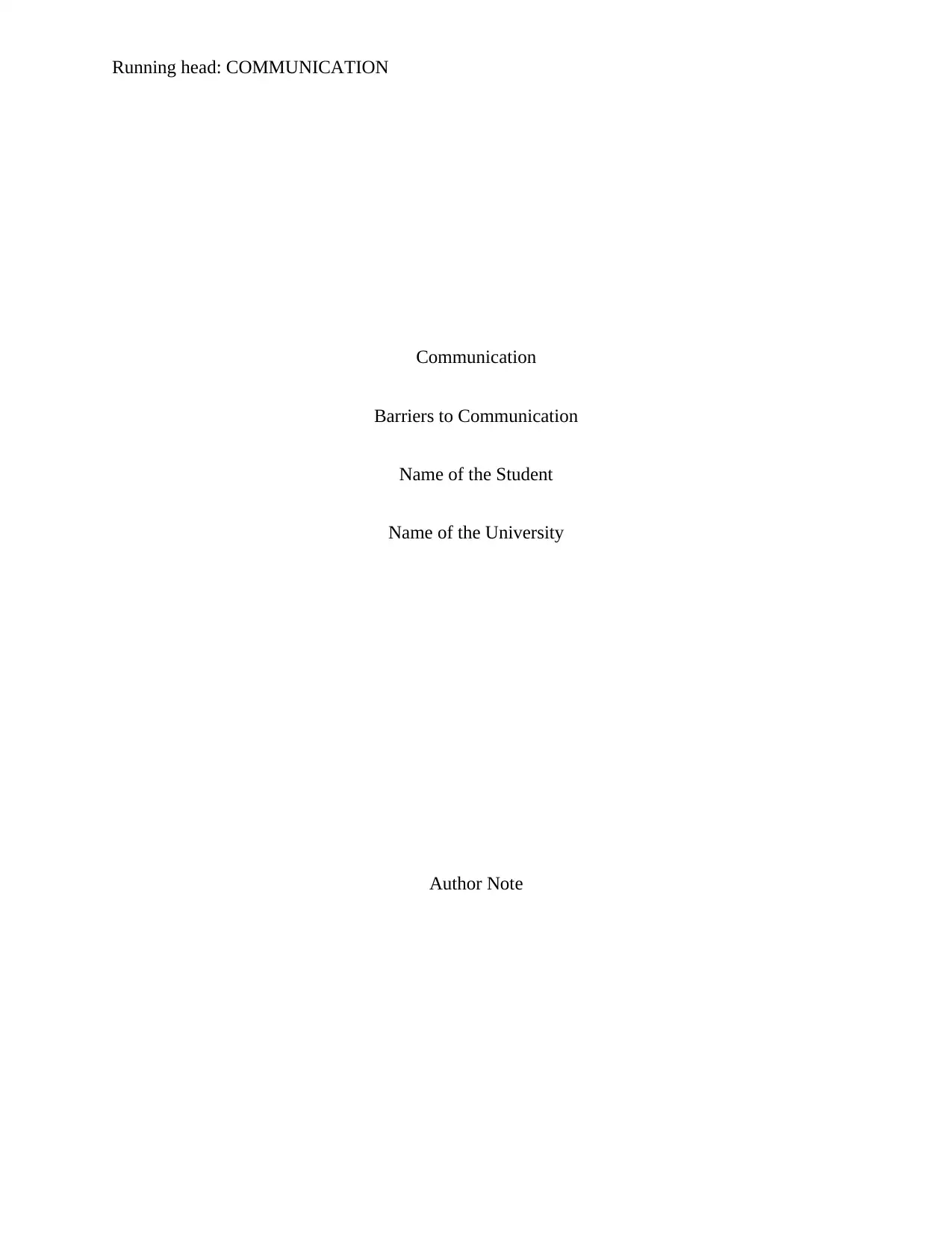
Running head: COMMUNICATION
Communication
Barriers to Communication
Name of the Student
Name of the University
Author Note
Communication
Barriers to Communication
Name of the Student
Name of the University
Author Note
Paraphrase This Document
Need a fresh take? Get an instant paraphrase of this document with our AI Paraphraser
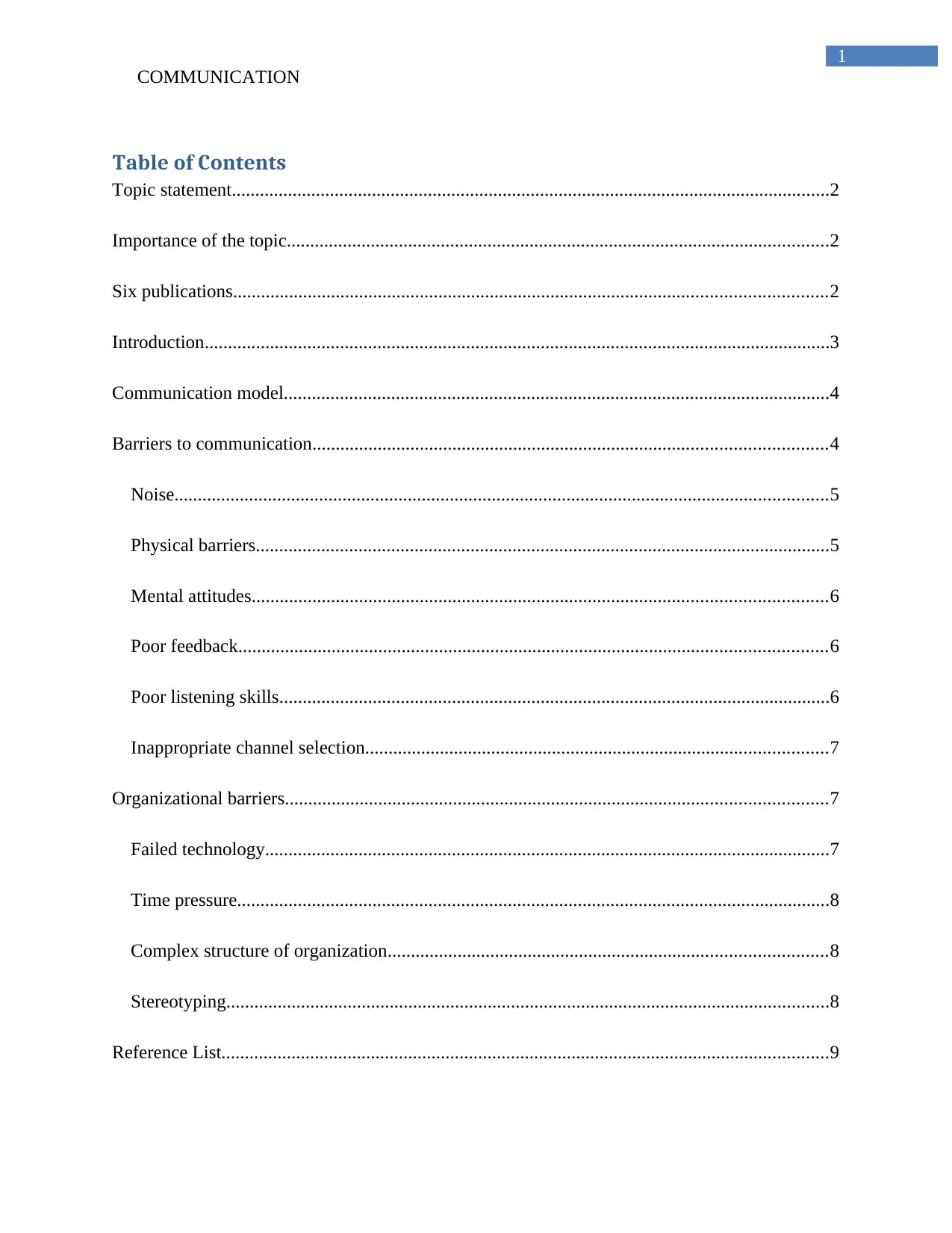
1
COMMUNICATION
Table of Contents
Topic statement................................................................................................................................2
Importance of the topic....................................................................................................................2
Six publications...............................................................................................................................2
Introduction......................................................................................................................................3
Communication model.....................................................................................................................4
Barriers to communication..............................................................................................................4
Noise............................................................................................................................................5
Physical barriers...........................................................................................................................5
Mental attitudes...........................................................................................................................6
Poor feedback..............................................................................................................................6
Poor listening skills......................................................................................................................6
Inappropriate channel selection...................................................................................................7
Organizational barriers....................................................................................................................7
Failed technology.........................................................................................................................7
Time pressure...............................................................................................................................8
Complex structure of organization..............................................................................................8
Stereotyping.................................................................................................................................8
Reference List..................................................................................................................................9
COMMUNICATION
Table of Contents
Topic statement................................................................................................................................2
Importance of the topic....................................................................................................................2
Six publications...............................................................................................................................2
Introduction......................................................................................................................................3
Communication model.....................................................................................................................4
Barriers to communication..............................................................................................................4
Noise............................................................................................................................................5
Physical barriers...........................................................................................................................5
Mental attitudes...........................................................................................................................6
Poor feedback..............................................................................................................................6
Poor listening skills......................................................................................................................6
Inappropriate channel selection...................................................................................................7
Organizational barriers....................................................................................................................7
Failed technology.........................................................................................................................7
Time pressure...............................................................................................................................8
Complex structure of organization..............................................................................................8
Stereotyping.................................................................................................................................8
Reference List..................................................................................................................................9
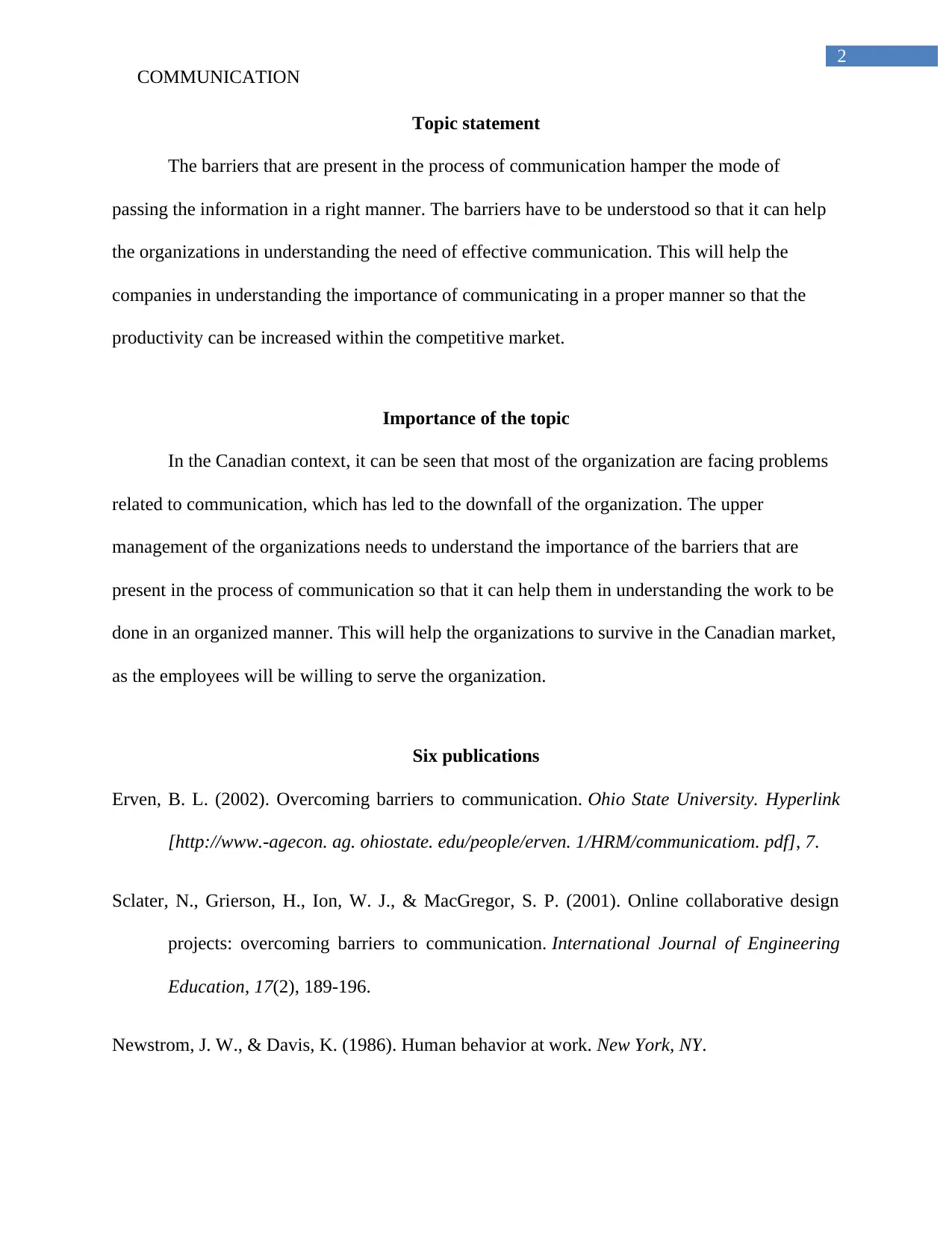
2
COMMUNICATION
Topic statement
The barriers that are present in the process of communication hamper the mode of
passing the information in a right manner. The barriers have to be understood so that it can help
the organizations in understanding the need of effective communication. This will help the
companies in understanding the importance of communicating in a proper manner so that the
productivity can be increased within the competitive market.
Importance of the topic
In the Canadian context, it can be seen that most of the organization are facing problems
related to communication, which has led to the downfall of the organization. The upper
management of the organizations needs to understand the importance of the barriers that are
present in the process of communication so that it can help them in understanding the work to be
done in an organized manner. This will help the organizations to survive in the Canadian market,
as the employees will be willing to serve the organization.
Six publications
Erven, B. L. (2002). Overcoming barriers to communication. Ohio State University. Hyperlink
[http://www.-agecon. ag. ohiostate. edu/people/erven. 1/HRM/communicatiom. pdf], 7.
Sclater, N., Grierson, H., Ion, W. J., & MacGregor, S. P. (2001). Online collaborative design
projects: overcoming barriers to communication. International Journal of Engineering
Education, 17(2), 189-196.
Newstrom, J. W., & Davis, K. (1986). Human behavior at work. New York, NY.
COMMUNICATION
Topic statement
The barriers that are present in the process of communication hamper the mode of
passing the information in a right manner. The barriers have to be understood so that it can help
the organizations in understanding the need of effective communication. This will help the
companies in understanding the importance of communicating in a proper manner so that the
productivity can be increased within the competitive market.
Importance of the topic
In the Canadian context, it can be seen that most of the organization are facing problems
related to communication, which has led to the downfall of the organization. The upper
management of the organizations needs to understand the importance of the barriers that are
present in the process of communication so that it can help them in understanding the work to be
done in an organized manner. This will help the organizations to survive in the Canadian market,
as the employees will be willing to serve the organization.
Six publications
Erven, B. L. (2002). Overcoming barriers to communication. Ohio State University. Hyperlink
[http://www.-agecon. ag. ohiostate. edu/people/erven. 1/HRM/communicatiom. pdf], 7.
Sclater, N., Grierson, H., Ion, W. J., & MacGregor, S. P. (2001). Online collaborative design
projects: overcoming barriers to communication. International Journal of Engineering
Education, 17(2), 189-196.
Newstrom, J. W., & Davis, K. (1986). Human behavior at work. New York, NY.
⊘ This is a preview!⊘
Do you want full access?
Subscribe today to unlock all pages.

Trusted by 1+ million students worldwide
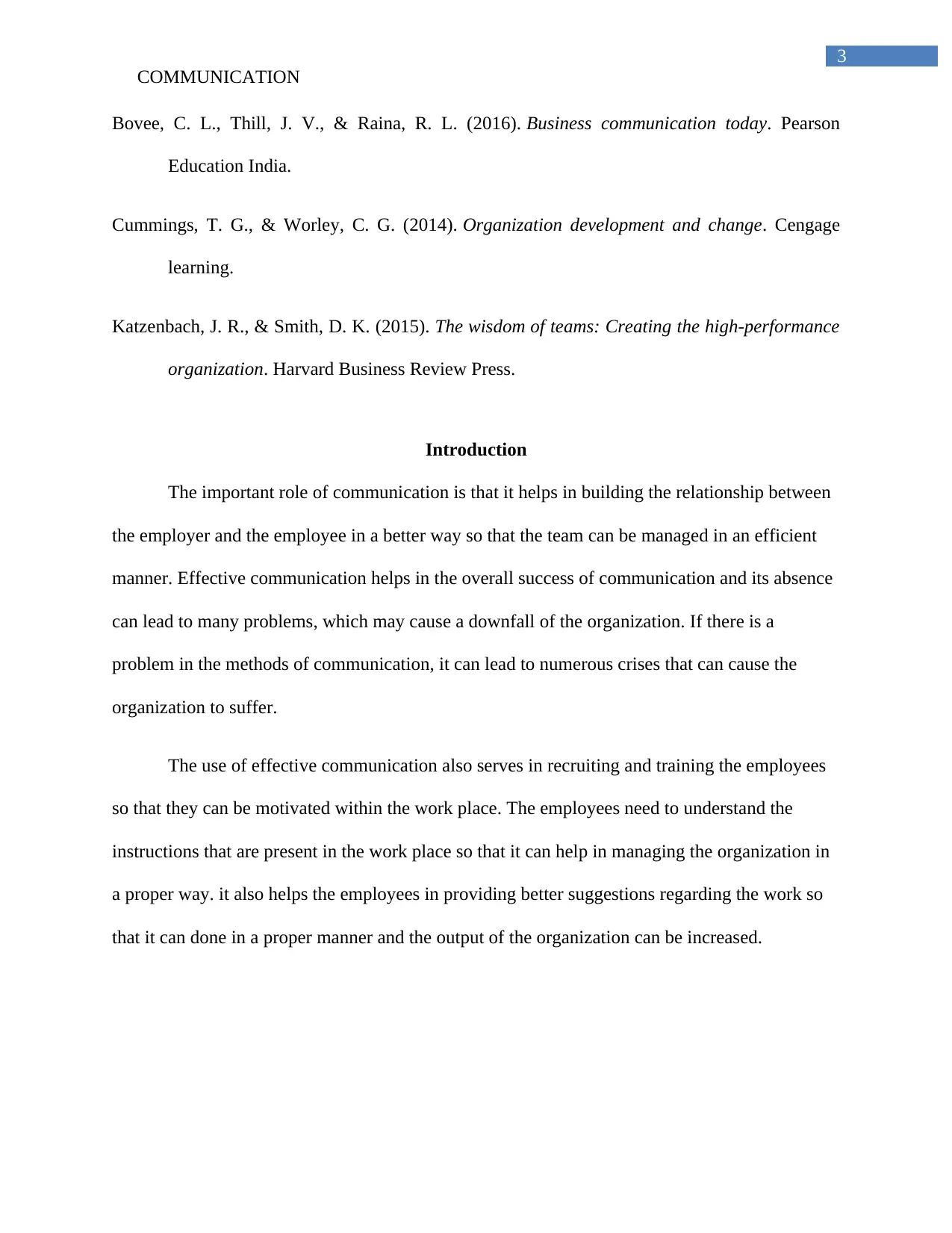
3
COMMUNICATION
Bovee, C. L., Thill, J. V., & Raina, R. L. (2016). Business communication today. Pearson
Education India.
Cummings, T. G., & Worley, C. G. (2014). Organization development and change. Cengage
learning.
Katzenbach, J. R., & Smith, D. K. (2015). The wisdom of teams: Creating the high-performance
organization. Harvard Business Review Press.
Introduction
The important role of communication is that it helps in building the relationship between
the employer and the employee in a better way so that the team can be managed in an efficient
manner. Effective communication helps in the overall success of communication and its absence
can lead to many problems, which may cause a downfall of the organization. If there is a
problem in the methods of communication, it can lead to numerous crises that can cause the
organization to suffer.
The use of effective communication also serves in recruiting and training the employees
so that they can be motivated within the work place. The employees need to understand the
instructions that are present in the work place so that it can help in managing the organization in
a proper way. it also helps the employees in providing better suggestions regarding the work so
that it can done in a proper manner and the output of the organization can be increased.
COMMUNICATION
Bovee, C. L., Thill, J. V., & Raina, R. L. (2016). Business communication today. Pearson
Education India.
Cummings, T. G., & Worley, C. G. (2014). Organization development and change. Cengage
learning.
Katzenbach, J. R., & Smith, D. K. (2015). The wisdom of teams: Creating the high-performance
organization. Harvard Business Review Press.
Introduction
The important role of communication is that it helps in building the relationship between
the employer and the employee in a better way so that the team can be managed in an efficient
manner. Effective communication helps in the overall success of communication and its absence
can lead to many problems, which may cause a downfall of the organization. If there is a
problem in the methods of communication, it can lead to numerous crises that can cause the
organization to suffer.
The use of effective communication also serves in recruiting and training the employees
so that they can be motivated within the work place. The employees need to understand the
instructions that are present in the work place so that it can help in managing the organization in
a proper way. it also helps the employees in providing better suggestions regarding the work so
that it can done in a proper manner and the output of the organization can be increased.
Paraphrase This Document
Need a fresh take? Get an instant paraphrase of this document with our AI Paraphraser
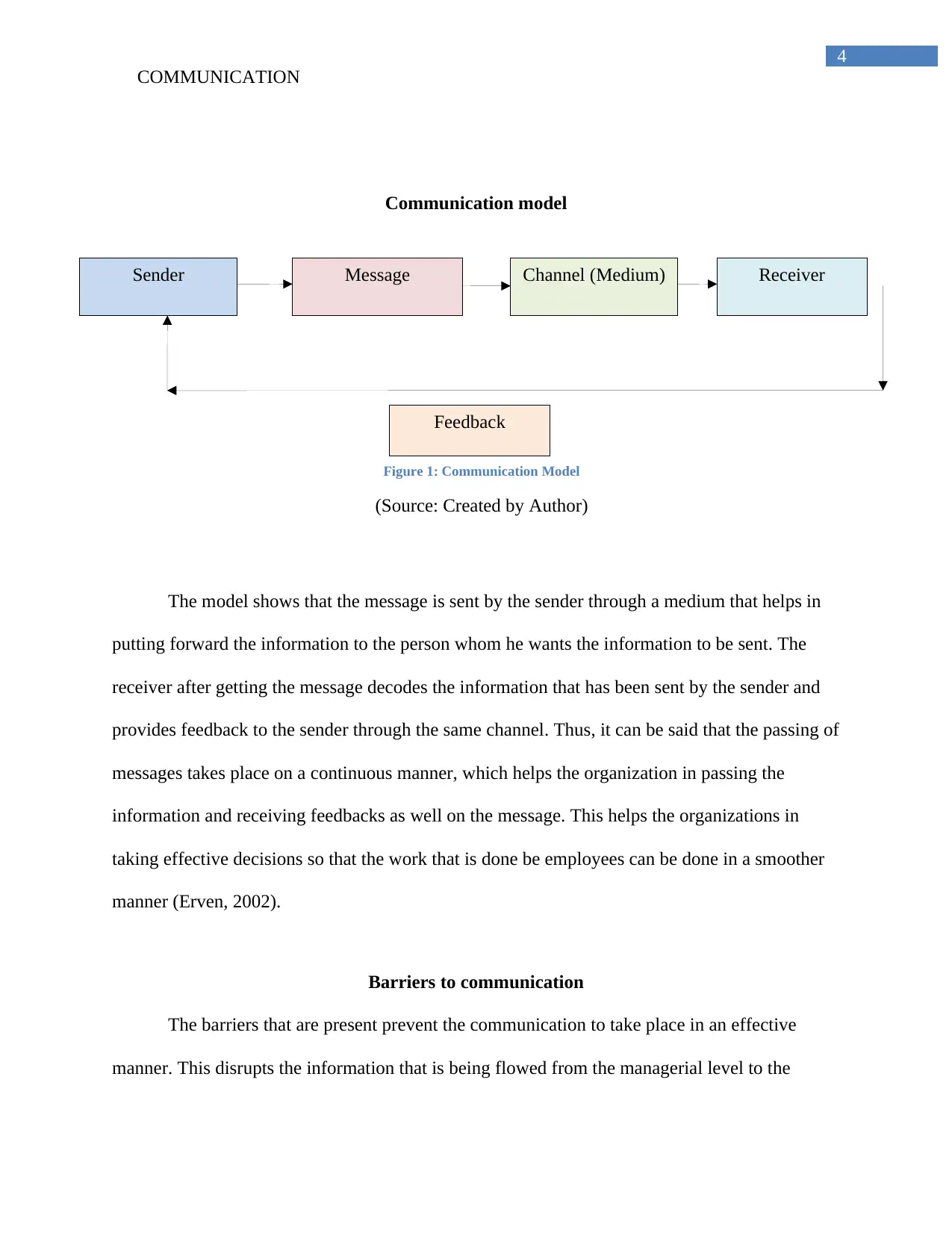
4
COMMUNICATION
Sender Message Channel (Medium) Receiver
Feedback
Communication model
The model shows that the message is sent by the sender through a medium that helps in
putting forward the information to the person whom he wants the information to be sent. The
receiver after getting the message decodes the information that has been sent by the sender and
provides feedback to the sender through the same channel. Thus, it can be said that the passing of
messages takes place on a continuous manner, which helps the organization in passing the
information and receiving feedbacks as well on the message. This helps the organizations in
taking effective decisions so that the work that is done be employees can be done in a smoother
manner (Erven, 2002).
Barriers to communication
The barriers that are present prevent the communication to take place in an effective
manner. This disrupts the information that is being flowed from the managerial level to the
Figure 1: Communication Model
(Source: Created by Author)
COMMUNICATION
Sender Message Channel (Medium) Receiver
Feedback
Communication model
The model shows that the message is sent by the sender through a medium that helps in
putting forward the information to the person whom he wants the information to be sent. The
receiver after getting the message decodes the information that has been sent by the sender and
provides feedback to the sender through the same channel. Thus, it can be said that the passing of
messages takes place on a continuous manner, which helps the organization in passing the
information and receiving feedbacks as well on the message. This helps the organizations in
taking effective decisions so that the work that is done be employees can be done in a smoother
manner (Erven, 2002).
Barriers to communication
The barriers that are present prevent the communication to take place in an effective
manner. This disrupts the information that is being flowed from the managerial level to the
Figure 1: Communication Model
(Source: Created by Author)
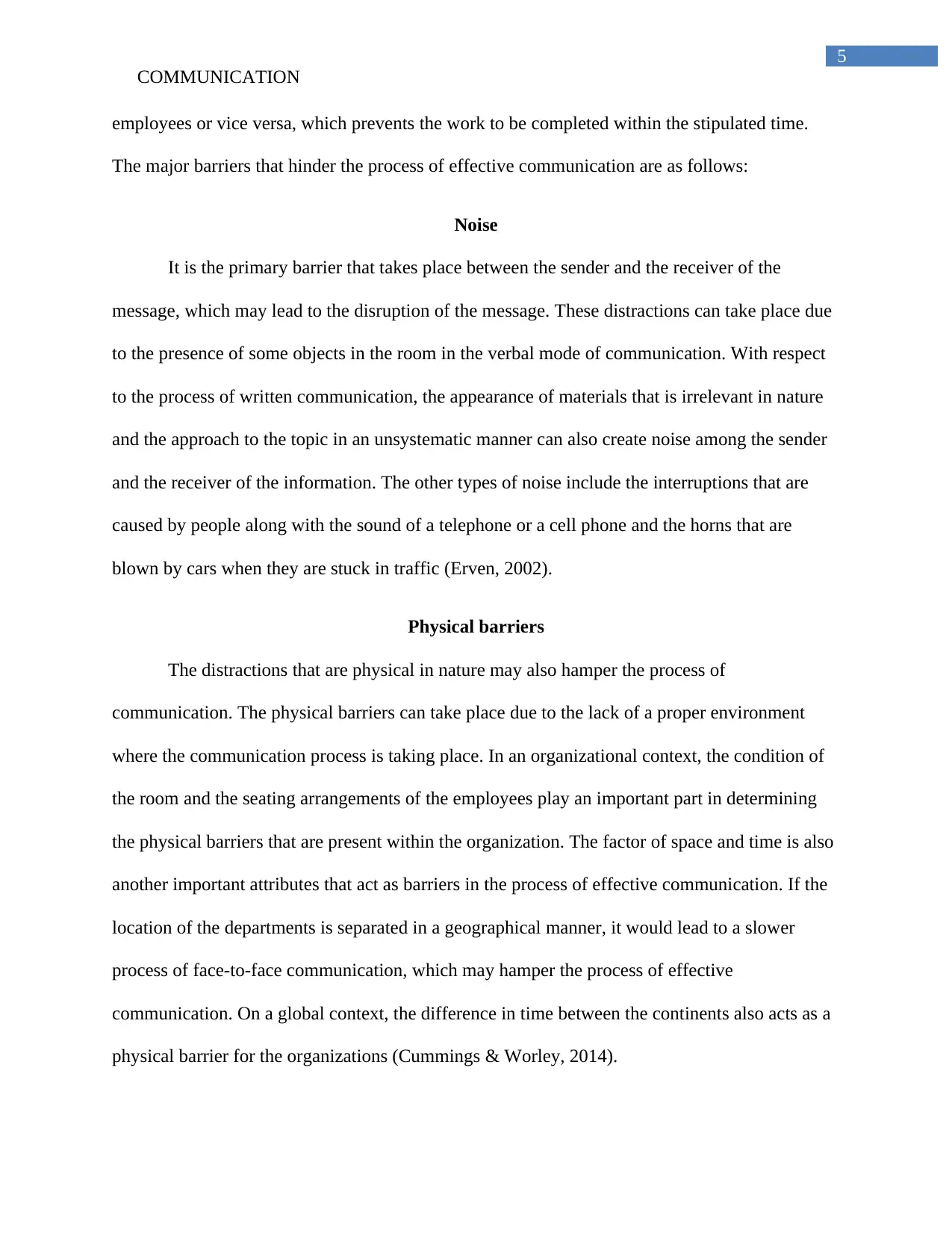
5
COMMUNICATION
employees or vice versa, which prevents the work to be completed within the stipulated time.
The major barriers that hinder the process of effective communication are as follows:
Noise
It is the primary barrier that takes place between the sender and the receiver of the
message, which may lead to the disruption of the message. These distractions can take place due
to the presence of some objects in the room in the verbal mode of communication. With respect
to the process of written communication, the appearance of materials that is irrelevant in nature
and the approach to the topic in an unsystematic manner can also create noise among the sender
and the receiver of the information. The other types of noise include the interruptions that are
caused by people along with the sound of a telephone or a cell phone and the horns that are
blown by cars when they are stuck in traffic (Erven, 2002).
Physical barriers
The distractions that are physical in nature may also hamper the process of
communication. The physical barriers can take place due to the lack of a proper environment
where the communication process is taking place. In an organizational context, the condition of
the room and the seating arrangements of the employees play an important part in determining
the physical barriers that are present within the organization. The factor of space and time is also
another important attributes that act as barriers in the process of effective communication. If the
location of the departments is separated in a geographical manner, it would lead to a slower
process of face-to-face communication, which may hamper the process of effective
communication. On a global context, the difference in time between the continents also acts as a
physical barrier for the organizations (Cummings & Worley, 2014).
COMMUNICATION
employees or vice versa, which prevents the work to be completed within the stipulated time.
The major barriers that hinder the process of effective communication are as follows:
Noise
It is the primary barrier that takes place between the sender and the receiver of the
message, which may lead to the disruption of the message. These distractions can take place due
to the presence of some objects in the room in the verbal mode of communication. With respect
to the process of written communication, the appearance of materials that is irrelevant in nature
and the approach to the topic in an unsystematic manner can also create noise among the sender
and the receiver of the information. The other types of noise include the interruptions that are
caused by people along with the sound of a telephone or a cell phone and the horns that are
blown by cars when they are stuck in traffic (Erven, 2002).
Physical barriers
The distractions that are physical in nature may also hamper the process of
communication. The physical barriers can take place due to the lack of a proper environment
where the communication process is taking place. In an organizational context, the condition of
the room and the seating arrangements of the employees play an important part in determining
the physical barriers that are present within the organization. The factor of space and time is also
another important attributes that act as barriers in the process of effective communication. If the
location of the departments is separated in a geographical manner, it would lead to a slower
process of face-to-face communication, which may hamper the process of effective
communication. On a global context, the difference in time between the continents also acts as a
physical barrier for the organizations (Cummings & Worley, 2014).
⊘ This is a preview!⊘
Do you want full access?
Subscribe today to unlock all pages.

Trusted by 1+ million students worldwide
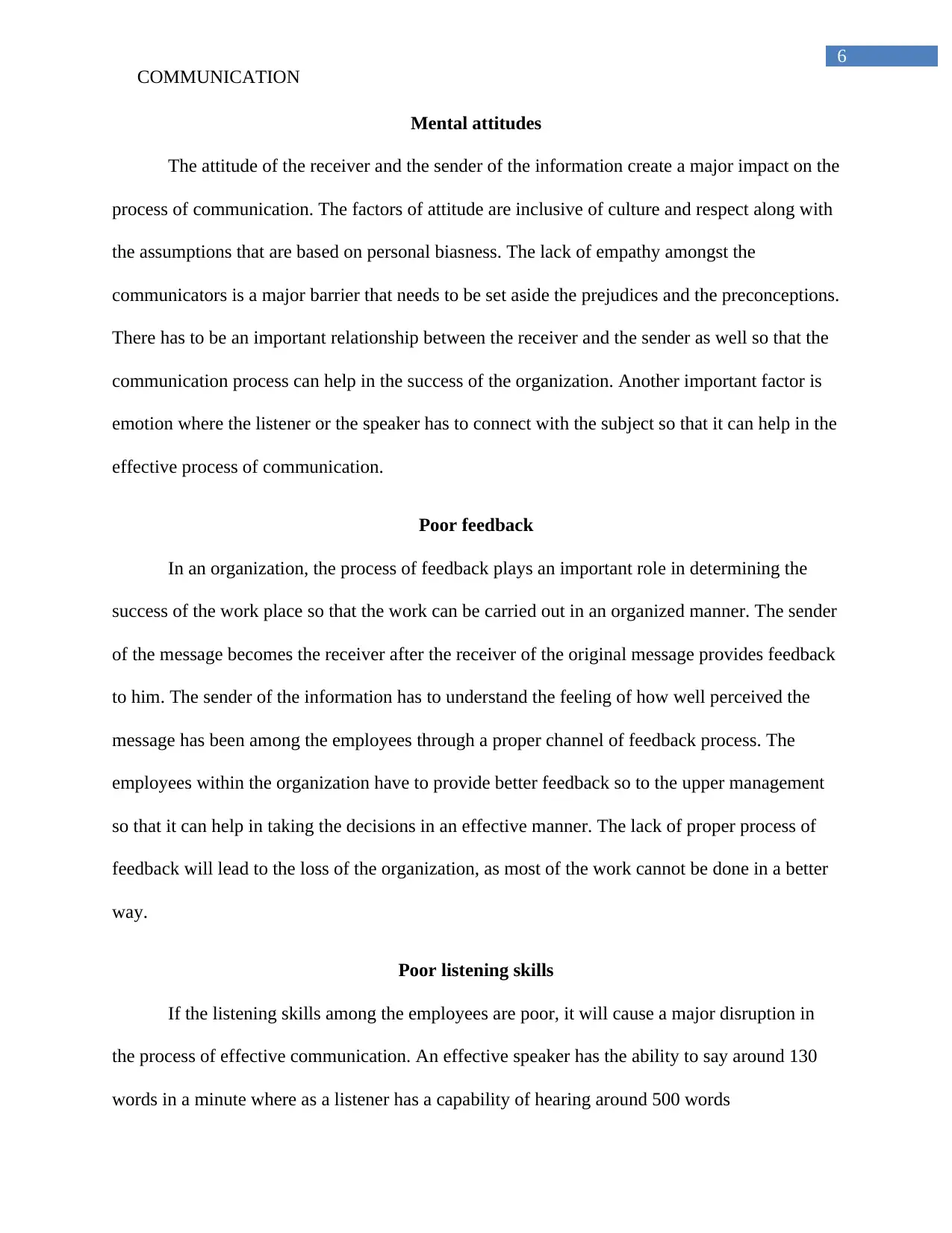
6
COMMUNICATION
Mental attitudes
The attitude of the receiver and the sender of the information create a major impact on the
process of communication. The factors of attitude are inclusive of culture and respect along with
the assumptions that are based on personal biasness. The lack of empathy amongst the
communicators is a major barrier that needs to be set aside the prejudices and the preconceptions.
There has to be an important relationship between the receiver and the sender as well so that the
communication process can help in the success of the organization. Another important factor is
emotion where the listener or the speaker has to connect with the subject so that it can help in the
effective process of communication.
Poor feedback
In an organization, the process of feedback plays an important role in determining the
success of the work place so that the work can be carried out in an organized manner. The sender
of the message becomes the receiver after the receiver of the original message provides feedback
to him. The sender of the information has to understand the feeling of how well perceived the
message has been among the employees through a proper channel of feedback process. The
employees within the organization have to provide better feedback so to the upper management
so that it can help in taking the decisions in an effective manner. The lack of proper process of
feedback will lead to the loss of the organization, as most of the work cannot be done in a better
way.
Poor listening skills
If the listening skills among the employees are poor, it will cause a major disruption in
the process of effective communication. An effective speaker has the ability to say around 130
words in a minute where as a listener has a capability of hearing around 500 words
COMMUNICATION
Mental attitudes
The attitude of the receiver and the sender of the information create a major impact on the
process of communication. The factors of attitude are inclusive of culture and respect along with
the assumptions that are based on personal biasness. The lack of empathy amongst the
communicators is a major barrier that needs to be set aside the prejudices and the preconceptions.
There has to be an important relationship between the receiver and the sender as well so that the
communication process can help in the success of the organization. Another important factor is
emotion where the listener or the speaker has to connect with the subject so that it can help in the
effective process of communication.
Poor feedback
In an organization, the process of feedback plays an important role in determining the
success of the work place so that the work can be carried out in an organized manner. The sender
of the message becomes the receiver after the receiver of the original message provides feedback
to him. The sender of the information has to understand the feeling of how well perceived the
message has been among the employees through a proper channel of feedback process. The
employees within the organization have to provide better feedback so to the upper management
so that it can help in taking the decisions in an effective manner. The lack of proper process of
feedback will lead to the loss of the organization, as most of the work cannot be done in a better
way.
Poor listening skills
If the listening skills among the employees are poor, it will cause a major disruption in
the process of effective communication. An effective speaker has the ability to say around 130
words in a minute where as a listener has a capability of hearing around 500 words
Paraphrase This Document
Need a fresh take? Get an instant paraphrase of this document with our AI Paraphraser
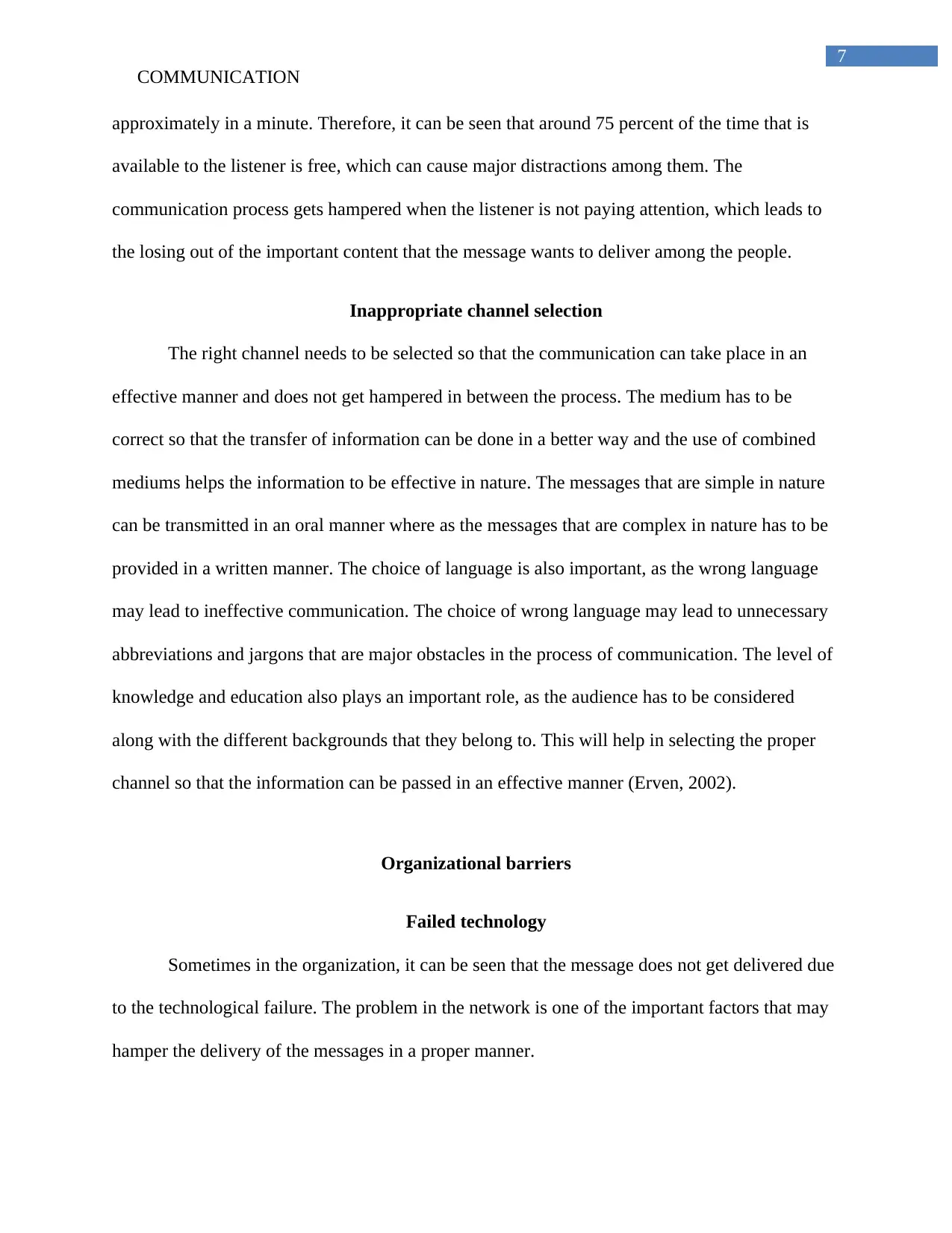
7
COMMUNICATION
approximately in a minute. Therefore, it can be seen that around 75 percent of the time that is
available to the listener is free, which can cause major distractions among them. The
communication process gets hampered when the listener is not paying attention, which leads to
the losing out of the important content that the message wants to deliver among the people.
Inappropriate channel selection
The right channel needs to be selected so that the communication can take place in an
effective manner and does not get hampered in between the process. The medium has to be
correct so that the transfer of information can be done in a better way and the use of combined
mediums helps the information to be effective in nature. The messages that are simple in nature
can be transmitted in an oral manner where as the messages that are complex in nature has to be
provided in a written manner. The choice of language is also important, as the wrong language
may lead to ineffective communication. The choice of wrong language may lead to unnecessary
abbreviations and jargons that are major obstacles in the process of communication. The level of
knowledge and education also plays an important role, as the audience has to be considered
along with the different backgrounds that they belong to. This will help in selecting the proper
channel so that the information can be passed in an effective manner (Erven, 2002).
Organizational barriers
Failed technology
Sometimes in the organization, it can be seen that the message does not get delivered due
to the technological failure. The problem in the network is one of the important factors that may
hamper the delivery of the messages in a proper manner.
COMMUNICATION
approximately in a minute. Therefore, it can be seen that around 75 percent of the time that is
available to the listener is free, which can cause major distractions among them. The
communication process gets hampered when the listener is not paying attention, which leads to
the losing out of the important content that the message wants to deliver among the people.
Inappropriate channel selection
The right channel needs to be selected so that the communication can take place in an
effective manner and does not get hampered in between the process. The medium has to be
correct so that the transfer of information can be done in a better way and the use of combined
mediums helps the information to be effective in nature. The messages that are simple in nature
can be transmitted in an oral manner where as the messages that are complex in nature has to be
provided in a written manner. The choice of language is also important, as the wrong language
may lead to ineffective communication. The choice of wrong language may lead to unnecessary
abbreviations and jargons that are major obstacles in the process of communication. The level of
knowledge and education also plays an important role, as the audience has to be considered
along with the different backgrounds that they belong to. This will help in selecting the proper
channel so that the information can be passed in an effective manner (Erven, 2002).
Organizational barriers
Failed technology
Sometimes in the organization, it can be seen that the message does not get delivered due
to the technological failure. The problem in the network is one of the important factors that may
hamper the delivery of the messages in a proper manner.
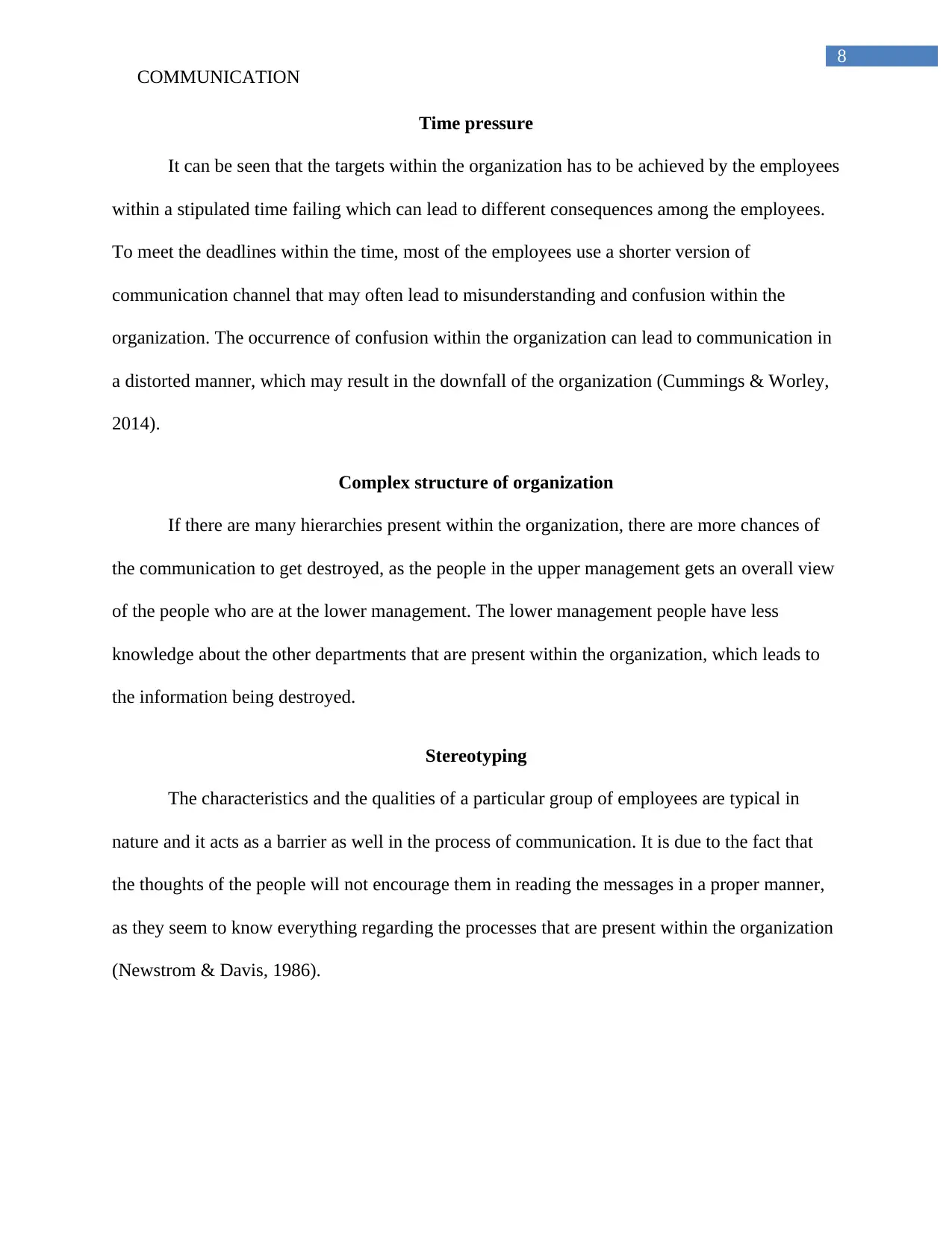
8
COMMUNICATION
Time pressure
It can be seen that the targets within the organization has to be achieved by the employees
within a stipulated time failing which can lead to different consequences among the employees.
To meet the deadlines within the time, most of the employees use a shorter version of
communication channel that may often lead to misunderstanding and confusion within the
organization. The occurrence of confusion within the organization can lead to communication in
a distorted manner, which may result in the downfall of the organization (Cummings & Worley,
2014).
Complex structure of organization
If there are many hierarchies present within the organization, there are more chances of
the communication to get destroyed, as the people in the upper management gets an overall view
of the people who are at the lower management. The lower management people have less
knowledge about the other departments that are present within the organization, which leads to
the information being destroyed.
Stereotyping
The characteristics and the qualities of a particular group of employees are typical in
nature and it acts as a barrier as well in the process of communication. It is due to the fact that
the thoughts of the people will not encourage them in reading the messages in a proper manner,
as they seem to know everything regarding the processes that are present within the organization
(Newstrom & Davis, 1986).
COMMUNICATION
Time pressure
It can be seen that the targets within the organization has to be achieved by the employees
within a stipulated time failing which can lead to different consequences among the employees.
To meet the deadlines within the time, most of the employees use a shorter version of
communication channel that may often lead to misunderstanding and confusion within the
organization. The occurrence of confusion within the organization can lead to communication in
a distorted manner, which may result in the downfall of the organization (Cummings & Worley,
2014).
Complex structure of organization
If there are many hierarchies present within the organization, there are more chances of
the communication to get destroyed, as the people in the upper management gets an overall view
of the people who are at the lower management. The lower management people have less
knowledge about the other departments that are present within the organization, which leads to
the information being destroyed.
Stereotyping
The characteristics and the qualities of a particular group of employees are typical in
nature and it acts as a barrier as well in the process of communication. It is due to the fact that
the thoughts of the people will not encourage them in reading the messages in a proper manner,
as they seem to know everything regarding the processes that are present within the organization
(Newstrom & Davis, 1986).
⊘ This is a preview!⊘
Do you want full access?
Subscribe today to unlock all pages.

Trusted by 1+ million students worldwide
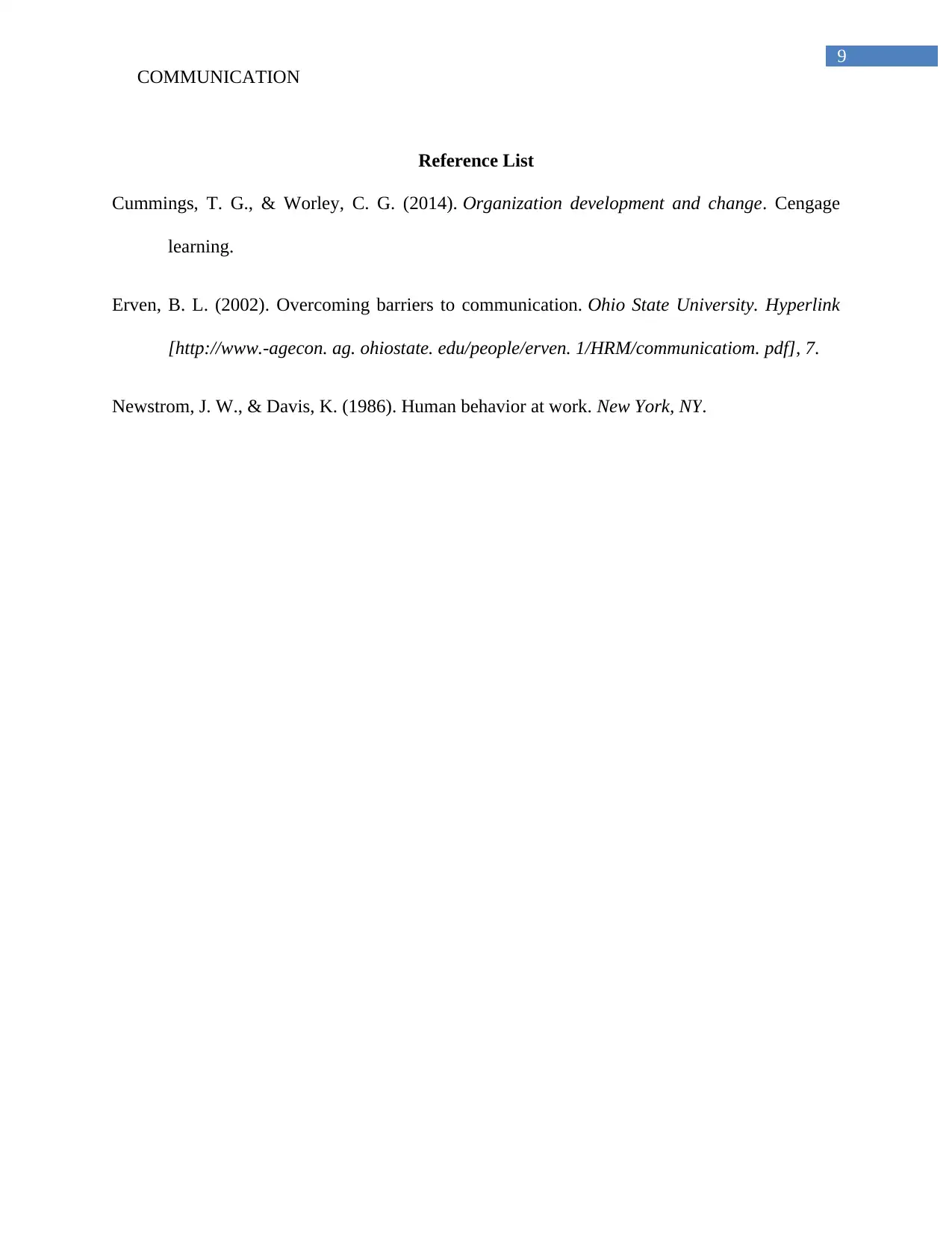
9
COMMUNICATION
Reference List
Cummings, T. G., & Worley, C. G. (2014). Organization development and change. Cengage
learning.
Erven, B. L. (2002). Overcoming barriers to communication. Ohio State University. Hyperlink
[http://www.-agecon. ag. ohiostate. edu/people/erven. 1/HRM/communicatiom. pdf], 7.
Newstrom, J. W., & Davis, K. (1986). Human behavior at work. New York, NY.
COMMUNICATION
Reference List
Cummings, T. G., & Worley, C. G. (2014). Organization development and change. Cengage
learning.
Erven, B. L. (2002). Overcoming barriers to communication. Ohio State University. Hyperlink
[http://www.-agecon. ag. ohiostate. edu/people/erven. 1/HRM/communicatiom. pdf], 7.
Newstrom, J. W., & Davis, K. (1986). Human behavior at work. New York, NY.
1 out of 10
Related Documents
Your All-in-One AI-Powered Toolkit for Academic Success.
+13062052269
info@desklib.com
Available 24*7 on WhatsApp / Email
![[object Object]](/_next/static/media/star-bottom.7253800d.svg)
Unlock your academic potential
Copyright © 2020–2025 A2Z Services. All Rights Reserved. Developed and managed by ZUCOL.




